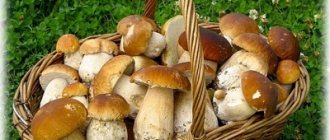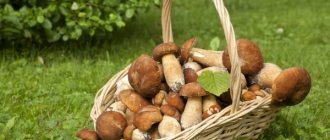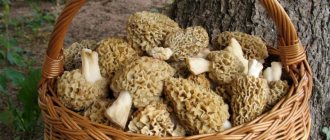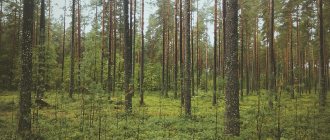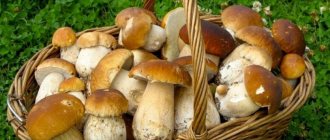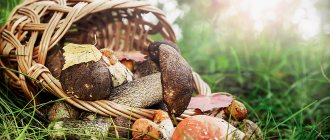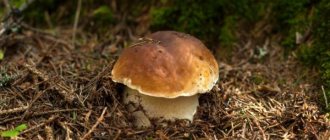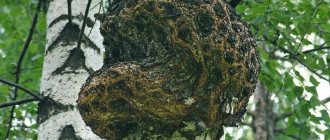Experts predicted the appearance of mushrooms near St. Petersburg in the near future. The heat left the city, the rains began, and this became a prerequisite for the growth of forest products. NEVSKIE NEWS tells what mushrooms grow in the forests of the Leningrad region.
Nevskie News / Sergey Pavlov
Experts predicted the appearance of mushrooms in St. Petersburg and the Leningrad region in August and September. According to them, this requires rain in the region. NEVSKIE NEWS has compiled a memo about which mushrooms are considered the best and which ones are best not to take so as not to get poisoned.
When going into the forest, it is advisable to take a knife with you along with your basket. It is better to cut the mushrooms at the very bottom of the stem so as not to damage the mycelium.
Before cooking mushrooms, it is advisable to clean them - scrape the stem, removing the thin top layer, clean the cap as much as possible, cutting off the peel. It is advisable to boil the mushrooms for 20–30 minutes, even if you are subsequently going to fry them.
White boletus, boletus, boletus
The three main mushrooms are white (sometimes called boletus), boletus (red, or red-headed) and boletus. The first, as usual, grows in spruce undergrowth, and the second and third - in aspen or birch trees, as follows from their name.
Nevskie News / Sergey Pavlov
These mushrooms are believed to have the most nutritional benefits. In addition, they are considered the most delicious. Experienced lovers of collecting forest gifts usually look only for them, skipping all other mushrooms. However, one can argue with this approach.
Nevskie News / Sergey Pavlov
White boletus, boletus and boletus are best fried or pickled. You can dry them for the winter and then cook soup. For drying, they usually use the oven, placing mushrooms cut into pieces on a wire rack covered with food foil. Someone simply strings them on threads, tying matches without heads to the ends of the threads, and hangs them on the heater.
Pr Scr vk.com/grib_spb /
Ringed cap
It grows from mid-summer until autumn. This plant can be used both fresh and pickled. You should be careful, since the plant can easily be confused with toadstool, but the annular cap itself is very tasty and is classified as edible. The photo shows a mushroom, but you shouldn’t trust the photos; it’s better to see the plant in person, from an experienced mushroom picker, and only then collect it:
Ringed cap
Chanterelles
Chanterelles are in no way inferior to the “main three”. Moreover, it is the most valuable mushroom in terms of fat content.
Chanterelles grow in groups of several. Experienced mushroom pickers know places where you can stumble upon entire glades of these mushrooms, collecting several baskets in a couple of hours.
Good housewives usually fry chanterelles or salt them. However, you can dry them and also cook soup in the winter.
wikipedia.org/Björn S/CC BY-SA 2.0
Saffron milk caps
It is best to collect in September, when there are a lot of saffron milk caps. These mushrooms are suitable for pickling, frying and boiling. In addition, saffron milk caps can be eaten raw, adding a little salt. It doesn't happen often, but if you know the specific germination spots, you can assemble a large basket.
The saffron milk caps themselves are inconspicuous, very reminiscent of redheads with a red or green tint. If you turn it over, the color will be bright orange. The mushroom has a delicate taste, but often they can be all wormy. In the photo you can see a representative:
Saffron milk caps
Mokhoviki
Next on the list are fly mushrooms and their varieties - for example, a mushroom called goat mushroom. As the name suggests, they prefer marshy areas with lots of moss. The peculiarity of this mushroom is that when cut, its pulp at the cut site immediately begins to turn blue. In addition, moss fly has a very pleasant smell.
This mushroom is good fried, dried and pickled. You can also salt it.
wikipedia.org / Ron Pastorino / CC BY-SA 3.0
About the artist
“The forest and nature have always been the most important and happiest part of my life. And among all the joys that the forest gives, mushrooms have caused me special delight since childhood. They have what awakens love: beauty and mystery. I have been drawing them for over thirty years. I began to see beauty that I had not noticed before. Now the humble russula can give me no less pleasure than a porcini mushroom. And the luxurious fly agaric mushrooms are a precious trophy for me. Like the people in the portraits, my characters are surrounded by objects from their native world: mosses, leaves, twigs.”
Alexander Vyazmensky – artist, naturalist, teacher.
“Alexander Vyazmensky (b. 1946 in Leningrad) is a master and popularizer of an amazing trend - botanical painting. His works are in many Russian and foreign collections, including the Minneapolis Institute of Arts, Farlow Library, Hunt Institute of Botanical Documentation (USA), London Botanical Garden, Lindley Library, Shirley Sherwood Collection (England), Grand Hotel Europe (St. Petersburg), private collections of America, England, Australia, Germany, the Netherlands. He illustrated the Red Book of Russia, the Red Book of St. Petersburg, the Red Book of the Novgorod Region and the Kola Encyclopedia. Airy and unusually realistic watercolors by Alexander Vyazmensky amaze with their scrupulous accuracy in conveying shapes and colors. His mushroom portraits are in perfect harmony with the white surface of the paper, giving the viewer’s imagination the opportunity to complete all the missing details of the forest where the depicted mushroom was found. And Alexander’s landscape sketches are not only mesmerizing, they beckon, calling you to kneel down and crawl to that tree, under which a porcini mushroom is hidden, covered with forest grass” (planet-gribov.rf - website of the St. Petersburg Mycological Society).
Butter
Another mushroom with an excellent smell was the butterdish. It got its name because of its oily, slippery-to-the-touch cap, to which small leaves and Christmas tree needles often stick. In most cases, on its leg there is a characteristic ring, which is called the “veil”.
Butter can also be fried, dried, pickled and salted. They are in no way inferior in taste to moss mushrooms.
wikipedia.org/vesna maric (kalipso)/CC BY-SA 3.0
Chernogolovka
Also known as birch grass. Many mushrooms can be found in late summer and early autumn. The plant is suitable for frying, drying and pickling. The mushroom is beautiful both in appearance and in its taste. As a rule, such a plant is not noticed by many mushroom pickers, since they hide very well and blend into the forest. The hat, as the name suggests, is black, but it can also be gray. In the photo you can see all the beauty of the plant:
Chernogolovka
Milk mushrooms
Mushroom pickers rarely come across milk mushrooms in the Leningrad region, but they are still present in the forests of the region. This mushroom is close to Russula and even comes from the same family - Russula.
Milk milk is usually white or yellowish in color, with plates under the cap (like russula). In most cases, these mushrooms are used for pickling.
wikipedia.org / Igor Lebedinsky / CC BY 3.0
Mushroom places of the Leningrad region
Each mushroom lover has his own treasured mushroom places with one or another type of mushroom. It's more difficult for beginners. Not every forest area pleases with mushroom diversity and productivity, and wandering at random in search of mushrooms is a waste of time. In addition, forest “dwellers” are known for their skill in camouflage.
In a dry year, it is better to look for mushrooms in lowlands and near water bodies. In rainy times, mushrooms grow more readily on hills and open areas (edges, clearings).
We offer you tips on the most popular mushroom destinations in the Leningrad region, and hundreds of brimming baskets are proof of this.
Vsevolozhsk district
Pine and spruce forests, heather and lichen forests predominate.
Direction to the village of Kovalevo, famous for its rich layer of boletus mushrooms; porcini mushrooms will also serve as a pleasant bonus. Near the village of Kerro, mushroom pickers will be pleased with a layer of butter. In the area of Devyatkino and Kavgolovo stations, chanterelles, boletus and boletus mushrooms have chosen the forest. The forest near the village of Oselki is the kingdom of boletuses, flywheels, porcini mushrooms and boletus mushrooms. Around Lake Lembolovskoe the forest area will give you boletus, chanterelles, flywheels and boletus.
Vyborgsk district
The forests contain mainly spruce and pine trees.
Not far from the village of Pervomaisky, you are guaranteed a basket of red caps with boletus mushrooms. The forest near the village of Kanneljärvi will delight you with chanterelles, russula and boletus. The territory of Mirror Lake and the old Finnish airfield (Veshchevo) is rich in mycelium of boletus, chanterelles and moss mushrooms. Mushroom places near Ryabovo, Baryshevo, Zverevo and Roshchino.
Kirovsky district
The forests are mixed, alternating between deciduous groves and coniferous forests.
Russula, caps, and chanterelles grow at 74 km. The village of Gory and the village of Sinyavino are quite popular among mushroom pickers; they are adjacent to mixed forests and there are pine forests. A little further is Lavrovo. The forests are rich in boletus, chanterelles, bitterweeds and honey mushrooms.
Lodeynopolsky district
The area is rich in dense spruce and pine forests.
The leading position and the most popular place among mushroom pickers is occupied by forests near the village of Alekhovshchina. There are many deciduous forests and a pine forest. This place is a real kingdom for chanterelles, several species of boletus, aspen boletus and moss fly. Porcini mushrooms dominate in the forests. The autumn forest will delight you with an abundance of saffron milk caps, wild mushrooms and corned beef.
Volkhovsky district
Mixed forests and not the same type of landscape, where swampy lowlands give way to forests.
Mushroom places are full of variety: boletus mushrooms, red caps, chanterelles and bitter mushrooms. The most popular places among mushroom pickers: the area of the village of Pasha, near the villages of Kiselnya and Chernoushevo, from Kolchanovo towards the village of Usadishte.
Priozersky district
The forests are mixed, dry, with a rich mushroom harvest.
Sosnovo and the village of Snegirevka are the most popular places for mushroom pickers. Multi-colored russula, chanterelles, volushki, bitter mushrooms, black milk mushrooms, boletus and aspen mushrooms. Mossy forests will delight you with porcini mushrooms. The forest near the village of Sapernoye is rich in redcaps, boletuses and chanterelles. The forest area near Priozersk is rich in porcini mushrooms and boletuses, the peak of which occurs in the first half of September.
Don’t forget about the “mushroom picker kit” when you go into the forest
Luga district
- Near the village of Zhemchuzhina Sanatorium, the forest will delight you with an abundance of chanterelles, boletus and redheads.
- The coastline of Copper Lake is rich in chanterelles, honey mushrooms and oyster mushrooms.
- Near the village of Serebryanka, lichen and mossy forests will delight you with chanterelles, moss mushrooms, boletus, corned beef: greenfinches, bitter mushrooms, black milk mushrooms. Variegated hedgehogs are abundant.
- The forests near the villages of Sorochkino (Luga training ground) and Shalovo will reward you with porcini mushrooms, aspen mushrooms, chanterelles and moss mushrooms.
In order not to turn a forest walk for mushrooms into a nightmare and panic, it is important to remember the rule: when getting out into an unfamiliar forest, do not forget about a compass, drinking water and a minimum set of things - in case you suddenly get lost in the forest.
Honey mushrooms
Honey mushrooms got their name due to the fact that they almost always grow on old rotten stumps with moss or next to them. Honey mushrooms have a thin stem and a yellow cap, which has a bright shade in the center.
A person with a good sense of smell will instantly distinguish honey fungus from any other mushroom. To do this, he just needs to smell it. The fact is that honey fungus has a specific fragrant odor. No other mushroom smells like this.
Honey mushrooms are good when fried, salted and pickled. These mushrooms should not be dried.
wikipedia.org/Strobilomyces/CC BY-SA 3.0
Kozlyaki
Goats can be used fresh and for pickling. In general, the mushrooms are good, tasty and grow in clusters, which makes them easier to collect, but this plant has a peculiarity, namely high worminess. Having collected a full basket, in the end there may not be a single normal mushroom. It is recommended to collect after rains, then you can get clean goats without worms.
If you boil them, a purple tint will appear, but do not be afraid, for this species this is quite normal.
Bitters
Another mushroom that definitely needs to be mentioned is bittersweet. It somewhat resembles a milk mushroom, usually red-brown or pale purple in color. Under the cap it has plates, like russula or milk mushrooms. When you cut a bittersweet, a white milky juice, similar to milk, comes out from a hole in the very middle of the stem.
Bitter mushrooms are considered conditionally edible mushrooms, since they are initially very bitter (as is clear from the name). Before cooking, they need to be soaked in a pan of cold water for at least four days. After this, the bitterness goes away. This mushroom is simply great when salted.
wikipedia.org / Andreas Kunze / CC BY-SA 3.0
What to read about mushrooms?
– Materials of the forum of the St. Petersburg Mycological Society .
– VKontakte group of the St. Petersburg Mycological Society.
– Smirnov L.E., Krivosheev S.V., Hannibal F.B. Mushrooms of the Leningrad region and St. Petersburg. - St. Petersburg: Regional Publishing House, 2012.
– Journal “Planet of Mushrooms” of the St. Petersburg Mycological Society.
– Garibova L.V. Popular atlas-identifier. Mushrooms. – M.: Bustard, 2009.
– Dyakov Yu.T. Entertaining mycology. - M.: Book house "Librocom", 2013.
- Mushrooms. Great Encyclopedia. – Reader's Digest Publishing House, 2005.
– Red Book of Nature of the Leningrad Region. Volume 2. Plants and mushrooms. – St. Petersburg: Peace and Family, 2000.
– Chistovsky O. G. Familiar strangers. – L.: Lenizdat, 1990.
Russula
The most common mushroom in the vicinity of St. Petersburg turned out to be russula. There are a huge number of them in the forests of the Leningrad region. This is a mushroom with a white stem and a bright cap of various colors - red, yellow, green. Russulas are usually taken exclusively for salting.
wikipedia.org / Eric Steinert / CC BY-SA 3.0
Volnushki
They grow from mid-summer to mid-autumn. Can be used for pickling. It is recommended to collect volnushki in early autumn and late summer. The mushrooms are quite beautiful, but cooking takes time to clean them. Finding such a plant in the forest will not be difficult, since they have a noticeable pink hat with a characteristic fringe. They stand out perfectly against the background of moss and grass, as can be seen in the photo:
Volnushki
Fly agarics, toadstools and false
And in conclusion, I must say about mushrooms, which you should never take. These are fly agarics, pale toadstools and the so-called false porcini mushrooms.
If we are talking about fly agarics and toadstools, then everything is simple. The first is a bright red, green or yellow mushroom with characteristic white pimples on the cap and a ring on the stem. Toadstools are also easy to distinguish by their thin stalk and brightly poisonous appearance. It can sometimes be confused with honey mushroom, but we wrote above that the edible mushroom has a characteristic fragrant smell and grows on stumps.
wikipedia.org/George Chernilevsky/Public domain
But in the case of a false mushroom, you can make a mistake, as they say, for the rest of your life. It is also called “gorchak” or “gall mushroom” because it is very bitter, and eating it can lead to serious poisoning.
However, NEVSKIE NEWS knows how to distinguish false mushrooms from edible ones. Despite the fact that it looks like a white or boletus, it has a characteristic feature - its cap is pinkish underneath. In addition, there is another way to check the mushroom - you need to lick it from the underside of the cap, immediately spitting it out. If a person feels bitterness on the tongue, it means that it is bitter and should be thrown away.
wikipedia.org/Pumber/CC BY-SA 3.0
Shortly before this, it was reported that abnormal heat could seriously affect the harvest of berries and mushrooms this year. However, NEVSKIE NEWS found out that townspeople can hope to collect forest gifts in August and September.
Dmitry Matveev
- Reviewer
Share article on social networks
- tags
- #Petersburg
- #spb
- #lenoregion
- #Leningrad region
- #mushroom pickers
- #mushrooms
- #boletus
- #White mushroom
- #boletus
Favorable time
These organisms have a complex structure. Hidden under a layer of forest humus is a mycelium (mycelium). Fruiting bodies appear on the surface. The mycelium is active all year round , but requires warm soil for fruiting. At the end of spring, morels and strings appear in warmed meadows and clearings. These mushrooms open the season. After the May rains, in early June, moss mushrooms and boletus mushrooms appear. There is also an encounter with a porcini mushroom. They can be called scouts, since the main layer is still ahead.
A little later, the aspen fades, then the boletuses (redheads) begin to grow. Russulas and chanterelles peek timidly.
In summer, the layers do not last long, about a week. A full harvest of mushrooms is harvested in the fall. Almost all species grow during this period. Their growth becomes more intense. Specimens appear for which hot summer conditions are unacceptable. For the development of the fruiting body, the minimum soil temperature is from 5 to 10 degrees. The higher it is, the faster the mushroom grows.
For these plants, not only temperature is important, but also the level of humidity. In dry autumn, the catch of mushroom pickers will not be large. But these gifts of the forest do not like prolonged rains. But light frosts are not scary for them.

